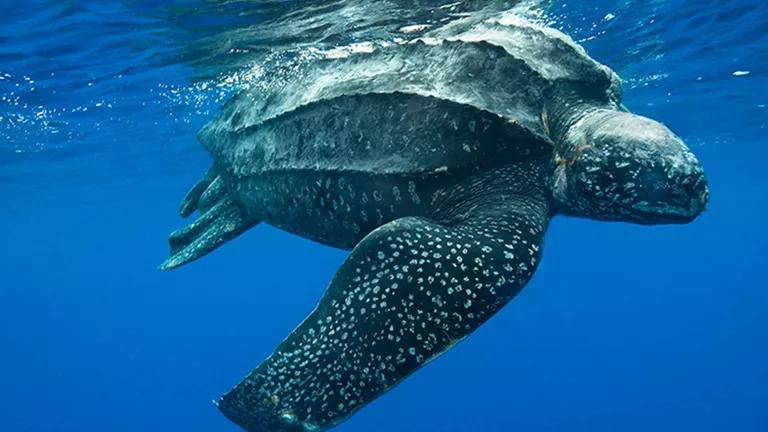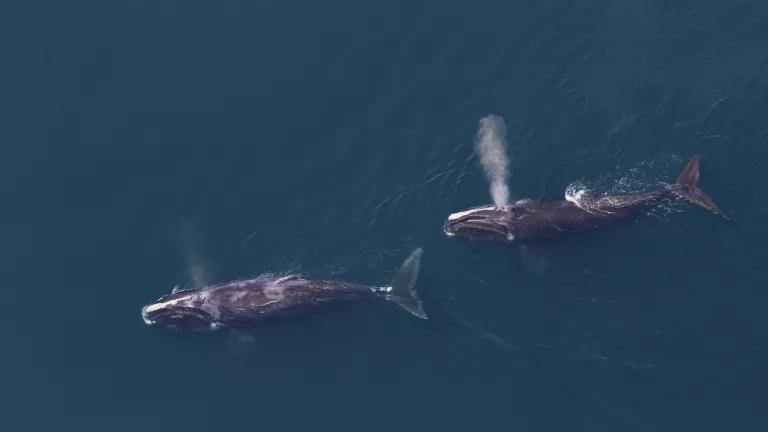
Leatherback sea turtles are one of several species vulnerable to entanglement, a potential risk associated with floating offshore wind energy development
To support the responsible development of floating offshore wind, NRDC has developed, in collaboration with other environmental groups, a set of monitoring and mitigation recommendations to reduce the technology’s potential entanglement risk to marine life.
The Biden administration has set its sights on leading the global community in the development of floating offshore wind, and recently committed to develop 15 gigawatts of floating offshore wind by 2035. To meet this ambitious target, the administration plans to reduce the cost of floating wind technology and make significant investments in research and development.
The new floating wind target is viewed by the administration as a logical expansion of the White House’s existing goal of 30 gigawatts of offshore wind by the end of the decade, and its larger ambition to decarbonize the nation’s electricity grid by 2035. Floating offshore wind has immense potential to provide clean energy to millions of Americans. The ability to construct floating platforms in waters as deep as 1,000 meters or greater will make offshore wind energy accessible to new areas of the United States, such as off the West Coast and in the Gulf of Maine, as well as areas far offshore.
Floating offshore wind technology has unique environmental considerations compared to fixed platform turbines. A key benefit of the technology over traditional monopiles is that it avoids the extremely loud noise generated by pile driving steel columns into the seabed. Instead, floating wind technology uses mooring lines and anchors to secure each turbine, and electricity is transmitted via dynamic array cables that are suspended in the middle of the water column. This underwater infrastructure represents a sizable footprint, particularly for a utility-scale project that may comprise 80 to 100 turbines each spaced approximately one nautical mile apart.

The mooring lines and mid-water cables associated with floating offshore wind infrastructure represent a sizeable underwater footprint and may pose an entanglement risk
The extensive underwater mooring and cable system presents a potential risk of entanglement of marine wildlife. “Secondary” entanglement is presumed to be the main entanglement-related concern for multiple species. This could occur if marine debris like lost fishing gear became ensnared around mooring lines and/or cables, or other infrastructure, and subsequently entangled marine wildlife. “Primary” entanglement, where an animal becomes directly entangled in the lines and cables, and “tertiary” entanglement, where marine debris or active fishing gear already entangling an animal becomes caught on the infrastructure and anchors the animal, are additional concerns that warrant monitoring as floating offshore wind development proceeds.
To advance floating offshore wind responsibly and avoid, minimize, and mitigate impacts on our vulnerable marine life, NRDC collaborated with other environmental groups on a set of recommendations to monitor for and reduce the risk of secondary entanglement for marine mammals, sea turtles, sharks, and diving or plunging marine birds.
The recommended monitoring approach uses multiple methods in parallel, allowing for continuous monitoring of unexpected weight or strain on mooring lines or cables, daily remote visual inspection of the mooring lines and cables close to the platforms, and monthly acoustic or remote visual inspections of the full length of the submerged structures. This multi-pronged approach is especially important as we build our understanding of entanglement risk associated with floating offshore wind technology.

With sufficient monitoring and mitigation, floating offshore wind can be advanced in a way that is protective of marine life
The construction of floating offshore wind in the U.S. is approximately five years away, which provides the time necessary to undertake research and development into the most effective and appropriate monitoring and mitigation systems and identify necessary cost efficiencies. Investment in monitoring of floating offshore wind developments will be of crucial importance to gather information on the likelihood and type of interactions with marine debris and vulnerable wildlife, and to inform future needs.




